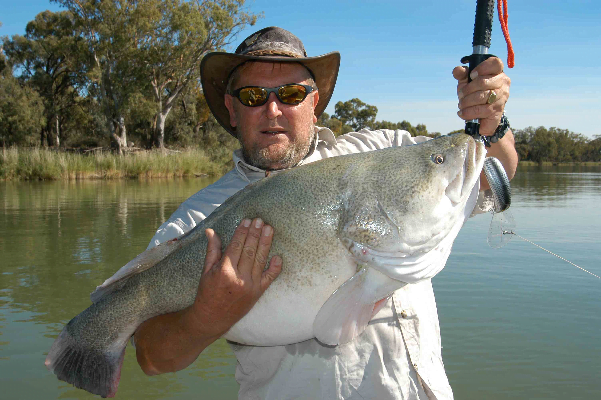IT is ten years since the launch of the ‘Native Fish Strategy for the Murray Darling Basin 2003-2013’ [1]. Hundreds of millions of dollars have been spent on the program including to re-snag the main channel of the Murray River with microchip embedded logs, building fish-ways and of course returning hundred of gigalitres of water. All of these initiatives should have helped restore populations of native fish, the objective of The Strategy. 
In January I asked the Murray Darling Basin Authority, MDBA, if there would be a formal assessment of the effectiveness of The Strategy ten years on. It was suggested that I consult Edition 34 of RipRap, a publication of the Australian River Restoration Centre dedicated to highlighting many of the achievements of The Strategy.
That edition of RipRap includes a variety of articles by leading scientists congratulating the MDBA, community and Landcare groups for their work helping to restore native fish populations as part of The Strategy. But many of the same articles include comment that native fish populations are still in decline and at no more than about 10 per cent of pre-European settlement levels. This 10 per cent is the same percentage estimated in 2003, when The Strategy was launched.
How could so much effort have been expended, so much money spent, for no gain?
A peer-reviewed paper published in 2011 explains that 12.89 million Murray cod have been produced at hatcheries since 1971 and released into the Murray Darling as part of a stock-enhancement strategy [3]. Surely one could assume that with all the effort to improve the in-stream habitat, combined with this tremendous restocking effort, there must at least have been an improvement in Murray Cod population numbers? But apparently we just don’t know. Indeed the technical paper by the Victorian scientists concludes that, “there is no information on the survival of stocked fish [Murray cod] to maturity.”
In 2003, the same year The Strategy was launched, Murray Cod was added to the national list of threatened species. There were media headlines referring to the species as “embattled” and its decline a sign that the Murray River was in trouble. We were told back then that more environmental flows would go a long way to returning Murray cod to sustainable levels.
As at 30 September 2012, the environmental water purchase program had already secured entitlements that will deliver, on average, 1,094 gigalitres of water each year worth $2.27 billion. The MDBA has also reported that more than 1,327 gigalitres of Commonwealth environmental water has been delivered.
All this water, and we don’t know whether Murray cod numbers have improved, but the best advice is that numbers are probably still in decline.
***
A version of this article first appeared in The Land newspaper in February 2013.
References/Links
1. Native Fish Strategy for the Murray-Darling Basin 2003-2013
http://www2.mdbc.gov.au/__data/page/65/Fish-Strat_ful.pdf
2. Edition 34: Bringing back native fish
http://australianriverrestorationcentre.com.au/riprap-is-back-edition-34-bringing-back-native-fish/
3. Impact of stock enhancement strategies on the effective population size of Murry cod, Maccullochella peelii, a threatened Australian fish. BA Ingram, B Hayes & ML Rourk 2011. Fisheries Management and Ecology 18: 467-481


 Jennifer Marohasy BSc PhD is a critical thinker with expertise in the scientific method.
Jennifer Marohasy BSc PhD is a critical thinker with expertise in the scientific method.

Hi Jennifer,
How credible is that oft quoted 10% of pre European fish stocks?
Does it refer to a pre European wet time or dry?
Or is it the most plucked out of thin air statistic ever?
P.S.
If I knew how to upload stuff I’d send you a picture of a beautiful 30 odd pounder caught (and released) on our place last month.
Dave
By the way, previously mentioned fish wasn’t caught or released by me….
If it was my catch it would have been filleted, poached in brine, wine and lime juice then baked in a white sauce with cheese on top !
Hey Dave
The 10 percent statistic was the result of the consensus of scientific opinion following a series of expert meetings of an expert panel.
You may remember that in my ‘Myth and the Murray’ monograph I explained how when they went out to try and catch some Murray cod they caught none – despite two years of trying and a $2 million budget. That was in a stretch of river that at the same time had a commercial catch of 26 tonnes of Murray Cod. see page 12 of http://www.ipa.org.au/publications/449/myth-and-the-murray-measuring-the-real-state-of-the-environment
I would really appreciate a picture of the fish you caught… see if you can get someone to show you how to attach it to an email and send to jennifermarohasy at yahoo.com.au
OK. I was posting at the same time as you… a picture of the fish that got away after you took the photograph would be great. 😉
Instead of quoting the consensus expert panel who obviously have precious little fishing skills, why didn’t they ask the people who can fish? ? ? ?
There have been heaps of cod caught in our area. One of my friends likes to kiss them and then release them 🙂
I should be able to get you some pics as well.
We have all noticed less carp and more native fish since the drought broke.
Not sure how much it has to do with the Native Fish Strategy. . . . but . . . SURELY it had some impact? ? ?
The strategy has really changed things a lot. The environmental flow enhanced flood about this time last year caused a shocking black water event, just as the Murray Crayfish were emerging. The resulting carnage has caused the closure of all waters excepting from Hume Weir to Yarrawonga to crayfishing.
Over fishing took the blame of course, not the “experts”.
Any fool can tell that the small remaining area is about to get fished to death .
People are getting good catches of native fish , as Debbie says , since the rains started. But carp are unfortunately recovering now too.
I don’t hold out much hope of any major success unaccompanied by major disasters so long as parachuted “experts ” do not listen to local fish experts.
The Shooters and Fishers Party have contributed in NSW by allowing the sale of Snowy Hydro in return for $80,000 of electoral funding.
A quick look at the segment of “Muddied Waters ” ,featuring the Snowy Hydro expert, give a clue what that will do to the fish. More black water and sudden bottom flows of cold water.
whilst looking for something else I came across this page:
http://www.transcontinental.com.au/story/1556791/shocking-currents/?cs=34